arrived at 6am on December 11! Of course she is beautiful, and she is healthy.
As her parents and brother live here with us, I am busy. We are all busy!
Architectural ideas are percolating. The December light makes good photographs of buildings and their details hard for me to take, but I am seeing and reflecting.
Saturday, December 13, 2008
Wednesday, November 19, 2008
Asher Benjamin
Asher Benjamin's pattern books have been an important part of my research library for as long as I can remember. My copies of his 1827 and 1830 editions, reprinted by Dover Publications, are dog eared from years of use.  I remember when his first book, The Country Builder's Assistant - originally published in 1797, in a small size that would have fit easily into a carpenter's pocket - was finally reprinted in 1989, and my family members gleefully gave each other copies for Christmas.
I remember when his first book, The Country Builder's Assistant - originally published in 1797, in a small size that would have fit easily into a carpenter's pocket - was finally reprinted in 1989, and my family members gleefully gave each other copies for Christmas.
Initially, I used his books to study the trends - what builders and owners were thinking in the early 1800s - that I saw on the sea coast north of Boston, where I lived and worked. But I knew of only 2 actual copies of his designs, one in New Hampshire and another in Maine.
 Then in the 1990s I happened to tour the Oliver Phelps House in Suffield, Connecticut, a house in which Asher Benjamin actually worked. Soon after that I moved to western Vermont; here I see direct copies of plates from The American Builder's Companion (first edition published in 1806), and The Architect, or Practical House Carpentry (1830). I've since acquired two later volumes as well - Practice of Architecture (1833) and The Builder's Guide (1839).
Then in the 1990s I happened to tour the Oliver Phelps House in Suffield, Connecticut, a house in which Asher Benjamin actually worked. Soon after that I moved to western Vermont; here I see direct copies of plates from The American Builder's Companion (first edition published in 1806), and The Architect, or Practical House Carpentry (1830). I've since acquired two later volumes as well - Practice of Architecture (1833) and The Builder's Guide (1839).
Want to read more? The wikipedia entry on Asher Benjamin has recently been updated and is a wonderful resource.
 I remember when his first book, The Country Builder's Assistant - originally published in 1797, in a small size that would have fit easily into a carpenter's pocket - was finally reprinted in 1989, and my family members gleefully gave each other copies for Christmas.
I remember when his first book, The Country Builder's Assistant - originally published in 1797, in a small size that would have fit easily into a carpenter's pocket - was finally reprinted in 1989, and my family members gleefully gave each other copies for Christmas.Initially, I used his books to study the trends - what builders and owners were thinking in the early 1800s - that I saw on the sea coast north of Boston, where I lived and worked. But I knew of only 2 actual copies of his designs, one in New Hampshire and another in Maine.
 Then in the 1990s I happened to tour the Oliver Phelps House in Suffield, Connecticut, a house in which Asher Benjamin actually worked. Soon after that I moved to western Vermont; here I see direct copies of plates from The American Builder's Companion (first edition published in 1806), and The Architect, or Practical House Carpentry (1830). I've since acquired two later volumes as well - Practice of Architecture (1833) and The Builder's Guide (1839).
Then in the 1990s I happened to tour the Oliver Phelps House in Suffield, Connecticut, a house in which Asher Benjamin actually worked. Soon after that I moved to western Vermont; here I see direct copies of plates from The American Builder's Companion (first edition published in 1806), and The Architect, or Practical House Carpentry (1830). I've since acquired two later volumes as well - Practice of Architecture (1833) and The Builder's Guide (1839).Want to read more? The wikipedia entry on Asher Benjamin has recently been updated and is a wonderful resource.
Tuesday, November 18, 2008
Rumford Roasters
A Rumford Roaster is a combined stove and oven, built out of brick with iron inserts.  It was invented in about 1800 by Count Rumford (born American Benjamin Thompson in Woburn MA, 1753). Rumford worked for many years in Bavaria (where he was named "Count of the Holy Roman Empire" and thus picked up his trade name) and his design was most likely inspired by the German masonry stoves he saw there. German immigrants to the United States also built masonry stove here - you can see one in the German exhibit of the Frontier Culture Museum, in Staunton, VA.
It was invented in about 1800 by Count Rumford (born American Benjamin Thompson in Woburn MA, 1753). Rumford worked for many years in Bavaria (where he was named "Count of the Holy Roman Empire" and thus picked up his trade name) and his design was most likely inspired by the German masonry stoves he saw there. German immigrants to the United States also built masonry stove here - you can see one in the German exhibit of the Frontier Culture Museum, in Staunton, VA.
Recently I was at Lorenzo (built in 1807), an estate on the end of Lake Cazenovia. The estate is a NY Historic Site, and the house has what I think is a Rumford Roaster in its kitchen. The owner of Lorenzo, John Lincklaen, was an agent for the Holland Land Company, and traveled back and forth to the Continent on business. Count Rumford had lived in England and France - where he was well known as a scientist and inventor - and his stoves, fireplaces and roasters were well received in England. So perhaps Lincklaen had seen one in his travels, and brought the idea back home to Lorenzo.
But the only other Rumford Roaster I have seen is in Lynnfield, Massachusetts (it looks just like this picture). The Lorenzo kitchen fireplace has the same lower holes for pots and flues, but I'm not sure the roaster on the side is there.
This got me thinking - why aren't there more Rumford stoves like this? Rumford fireplaces were widely built from the late 1790's until 1840, when cast-iron stoves became available. The fireplaces of many homes were retrofitted with the new Rumford shape because it threw heat and drafted so much better than the earlier fireboxes. So why didn't the Roaster enjoy similar success? Perhaps because it wasn't just a matter of an easy retrofit, but would have entailed a reconstruction of the kitchen fireplace?
Rumford's work was published in the States in 1804. In 1811, Asher Benjamin, author of one of the most popular pattern books of its time, devoted 2 plates to a description of the Roaster in his Builder's Companion, so people had to be aware of the concept. Even though the cast iron fittings (the round object in the etching) for the roaster were not cheap, the masonry stove - with holes to set pots in, fire boxes below, and a flue connecting them to the rear (the rectangles on the right side in the illustration) - would have been pretty easy to construct. But I have read of only a few Rumford stoves, and they're in grand houses: Gore Place in Waltham, MA, the Rundlet-May House in Portsmouth, NH. In all the years I've been working on old houses, I've only come across two. Are there more?
Maybe they are hidden in plain sight, like the one at Lorenzo - there, but unrecognized. Please, let me know if you see one!
Note: Both Gore Place and the Rundlet-May House are now museums open to the public in season.
Additional Sources:
http://www.rumford.com/Rumford.html
Benjamin Thompson, Count Rumford, Sanborn C. Brown, MIT Press, 1981
 It was invented in about 1800 by Count Rumford (born American Benjamin Thompson in Woburn MA, 1753). Rumford worked for many years in Bavaria (where he was named "Count of the Holy Roman Empire" and thus picked up his trade name) and his design was most likely inspired by the German masonry stoves he saw there. German immigrants to the United States also built masonry stove here - you can see one in the German exhibit of the Frontier Culture Museum, in Staunton, VA.
It was invented in about 1800 by Count Rumford (born American Benjamin Thompson in Woburn MA, 1753). Rumford worked for many years in Bavaria (where he was named "Count of the Holy Roman Empire" and thus picked up his trade name) and his design was most likely inspired by the German masonry stoves he saw there. German immigrants to the United States also built masonry stove here - you can see one in the German exhibit of the Frontier Culture Museum, in Staunton, VA.Recently I was at Lorenzo (built in 1807), an estate on the end of Lake Cazenovia. The estate is a NY Historic Site, and the house has what I think is a Rumford Roaster in its kitchen. The owner of Lorenzo, John Lincklaen, was an agent for the Holland Land Company, and traveled back and forth to the Continent on business. Count Rumford had lived in England and France - where he was well known as a scientist and inventor - and his stoves, fireplaces and roasters were well received in England. So perhaps Lincklaen had seen one in his travels, and brought the idea back home to Lorenzo.
But the only other Rumford Roaster I have seen is in Lynnfield, Massachusetts (it looks just like this picture). The Lorenzo kitchen fireplace has the same lower holes for pots and flues, but I'm not sure the roaster on the side is there.
This got me thinking - why aren't there more Rumford stoves like this? Rumford fireplaces were widely built from the late 1790's until 1840, when cast-iron stoves became available. The fireplaces of many homes were retrofitted with the new Rumford shape because it threw heat and drafted so much better than the earlier fireboxes. So why didn't the Roaster enjoy similar success? Perhaps because it wasn't just a matter of an easy retrofit, but would have entailed a reconstruction of the kitchen fireplace?
Rumford's work was published in the States in 1804. In 1811, Asher Benjamin, author of one of the most popular pattern books of its time, devoted 2 plates to a description of the Roaster in his Builder's Companion, so people had to be aware of the concept. Even though the cast iron fittings (the round object in the etching) for the roaster were not cheap, the masonry stove - with holes to set pots in, fire boxes below, and a flue connecting them to the rear (the rectangles on the right side in the illustration) - would have been pretty easy to construct. But I have read of only a few Rumford stoves, and they're in grand houses: Gore Place in Waltham, MA, the Rundlet-May House in Portsmouth, NH. In all the years I've been working on old houses, I've only come across two. Are there more?
Maybe they are hidden in plain sight, like the one at Lorenzo - there, but unrecognized. Please, let me know if you see one!
Note: Both Gore Place and the Rundlet-May House are now museums open to the public in season.
Additional Sources:
http://www.rumford.com/Rumford.html
Benjamin Thompson, Count Rumford, Sanborn C. Brown, MIT Press, 1981
Thursday, October 16, 2008
Tonight at the Bennington Museum!
I will be speaking on original green tonight at 7 pm at the Bennington Museum.  This is an evening to celebrate the publication of their new journal the Wallomsack Review, and the authors of several other articles will also be speaking.
This is an evening to celebrate the publication of their new journal the Wallomsack Review, and the authors of several other articles will also be speaking.
I've expanded on both the original posts and the published article, with additional examples of original green design from around town, so I'm hoping that even if you've been following along from the beginning, you'll see something new and interesting.
The event is free - you can find more information here, and a link to the museum here.
 This is an evening to celebrate the publication of their new journal the Wallomsack Review, and the authors of several other articles will also be speaking.
This is an evening to celebrate the publication of their new journal the Wallomsack Review, and the authors of several other articles will also be speaking.I've expanded on both the original posts and the published article, with additional examples of original green design from around town, so I'm hoping that even if you've been following along from the beginning, you'll see something new and interesting.
The event is free - you can find more information here, and a link to the museum here.
Tuesday, September 23, 2008
Building to the weather - Part 6 of 7: The Big House is 'green' too
In a previous post, I described how the Park-McCullough's Carriage Barn uses 'original green' design to work with the climate. This post is about how the main house uses the same green techniques.
The Big House, as the family called their summer home, has porches designed to shield the first floor from the strong summer sunshine. Large windows - 7 ft tall by 3 ft wide - are set across from each other, making cross ventilation easy. The Observatory acts as a vent at the top of the House, just the cupola does on the Barn.
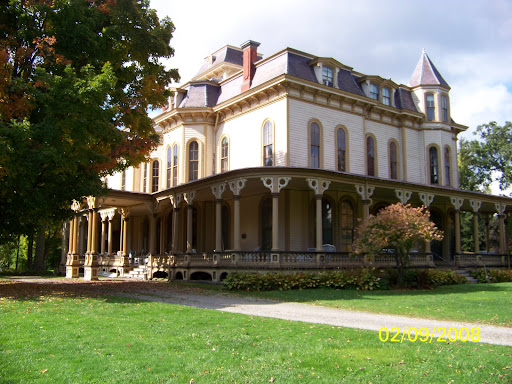
This photo shows how the deep porch keeps the main floor in the shade, while the master bedroom on the second floor front corner gets morning sun.
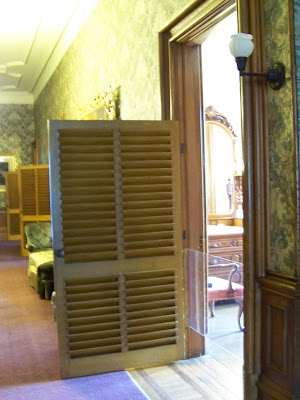
Shutters from bedrooms into the upstairs hall allow air flow across sleeping rooms and up though observatory - creating a summer breeze while preserving privacy. Screening for windows had not been invented when the Big House was built.

The Observatory: its vents work as do those in a cupola. It is also a wonderful place to look out over the countryside.
The 2 main entrances are to the south and east. The south entry is a weather entry (meaning two sets of doors that act like an air lock), and both are out of the wind.

The southern entry is at the center of the photo, with the tall window allowing light into the weather entry. In the 1890's the family added a breakfast room (visible at the end of the porch), which is sunny all day long.
Like the tack room at the Barn, there are rooms designed to be warm and bright. On the first floor the library (which became Lizzy Park McCullough's morning room) is a small room, easily heated, surrounded on three sides by the House. Similarly Laura Hall Park (Lizzy's mother) had her own room on the second floor. A beautiful room with a room-wide, floor-length bay window facing south, snugly set in the middle of the house, it has it's own fireplace. Laura did beautiful embroidery - she left some for us to admire. It is easy to imagine her sewing by the window.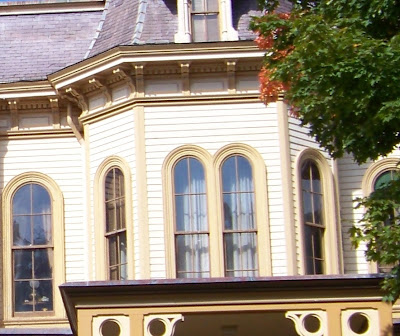
The south facing bay window floods Laura Hall Park's second floor morning room with light. A morning room was a Victorian lady's personal, informal space, an antidote to the formal entertaining rooms on the first floor.
The layout of the House brings light and sunshine into the family space on the second floor. The main bedrooms are on the east and south sides of the House, the swing rooms to the north.
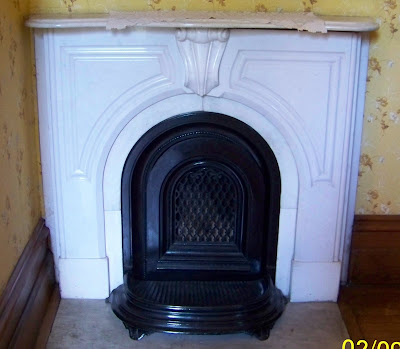 The House boasted a 'modern' central heating system when it was built in 1864, but all the rooms still had coal fireplaces (some were later reworked to be wood burning). All the rooms could be closed in with doors, shutters, and heavy floor length drapes.
The House boasted a 'modern' central heating system when it was built in 1864, but all the rooms still had coal fireplaces (some were later reworked to be wood burning). All the rooms could be closed in with doors, shutters, and heavy floor length drapes.
A typical bedroom fireplace with a coal insert.
The open second floor sitting room dates from the 1890's renovation, after the central heating system was upgraded.
Here is the whole series:
Part 1 - http://www.jgrarchitect.com/2008/04/building-to-weather.html
Part 2 - How does the carriage house work with the sun to minimize wind chill?
http://www.jgrarchitect.com/2008/04/building-to-weather-2.html
Part 3 - Why bother with a cupola?
http://www.jgrarchitect.com/2008/05/thats-pretty-amazing-cupola-with-all.html
Part 4 - Eaves? they're important?
http://www.jgrarchitect.com/2008/05/eaves-for-work-and-play.html
Part 5 - How a floor plan makes a difference:
http://www.jgrarchitect.com/2008/06/no-tech-warmth-with-low-tech-aid.html
Part 6 - A look at how these concepts were used at the Big House:
http://www.jgrarchitect.com/2008/09/big-house-is-green-too.html
Part 7 - Shutters:
http://www.jgrarchitect.com/2008/03/shutters-ok-i-know-that-they-were-for.ht
The Big House, as the family called their summer home, has porches designed to shield the first floor from the strong summer sunshine. Large windows - 7 ft tall by 3 ft wide - are set across from each other, making cross ventilation easy. The Observatory acts as a vent at the top of the House, just the cupola does on the Barn.

This photo shows how the deep porch keeps the main floor in the shade, while the master bedroom on the second floor front corner gets morning sun.

Shutters from bedrooms into the upstairs hall allow air flow across sleeping rooms and up though observatory - creating a summer breeze while preserving privacy. Screening for windows had not been invented when the Big House was built.
The Observatory: its vents work as do those in a cupola. It is also a wonderful place to look out over the countryside.
The 2 main entrances are to the south and east. The south entry is a weather entry (meaning two sets of doors that act like an air lock), and both are out of the wind.

The southern entry is at the center of the photo, with the tall window allowing light into the weather entry. In the 1890's the family added a breakfast room (visible at the end of the porch), which is sunny all day long.
Like the tack room at the Barn, there are rooms designed to be warm and bright. On the first floor the library (which became Lizzy Park McCullough's morning room) is a small room, easily heated, surrounded on three sides by the House. Similarly Laura Hall Park (Lizzy's mother) had her own room on the second floor. A beautiful room with a room-wide, floor-length bay window facing south, snugly set in the middle of the house, it has it's own fireplace. Laura did beautiful embroidery - she left some for us to admire. It is easy to imagine her sewing by the window.

The south facing bay window floods Laura Hall Park's second floor morning room with light. A morning room was a Victorian lady's personal, informal space, an antidote to the formal entertaining rooms on the first floor.
The layout of the House brings light and sunshine into the family space on the second floor. The main bedrooms are on the east and south sides of the House, the swing rooms to the north.
 The House boasted a 'modern' central heating system when it was built in 1864, but all the rooms still had coal fireplaces (some were later reworked to be wood burning). All the rooms could be closed in with doors, shutters, and heavy floor length drapes.
The House boasted a 'modern' central heating system when it was built in 1864, but all the rooms still had coal fireplaces (some were later reworked to be wood burning). All the rooms could be closed in with doors, shutters, and heavy floor length drapes.A typical bedroom fireplace with a coal insert.
The open second floor sitting room dates from the 1890's renovation, after the central heating system was upgraded.
Here is the whole series:
Part 1 - http://www.jgrarchitect.com/2008/04/building-to-weather.html
Part 2 - How does the carriage house work with the sun to minimize wind chill?
http://www.jgrarchitect.com/2008/04/building-to-weather-2.html
Part 3 - Why bother with a cupola?
http://www.jgrarchitect.com/2008/05/thats-pretty-amazing-cupola-with-all.html
Part 4 - Eaves? they're important?
http://www.jgrarchitect.com/2008/05/eaves-for-work-and-play.html
Part 5 - How a floor plan makes a difference:
http://www.jgrarchitect.com/2008/06/no-tech-warmth-with-low-tech-aid.html
Part 6 - A look at how these concepts were used at the Big House:
http://www.jgrarchitect.com/2008/09/big-house-is-green-too.html
Part 7 - Shutters:
http://www.jgrarchitect.com/2008/03/shutters-ok-i-know-that-they-were-for.ht
Friday, September 19, 2008
Bodkins from the Park-McCullough House
This is an ivory bodkin, photographed laying across oak flooring - it's about 4" long.

A "bodkin," you say? As in, Shakespeare's "Odd's Bodkin"? Yes, it's one and the same.
Bodkins were essential for dressing, before the inventions of buttons, hooks and eyes and of course, zippers. The bodkin is used much like a needle, to pull ribbon (or a leather strip) through a hem. The ribbon then becomes a tie to hold clothing together, such as on a cloak, chemise, laced vest, petticoat, or an apron. Only later, when we had other, more familiar ways to close clothing, did ribbons became merely decorative.
This bodkin is part of one of the needle kits owned the Park and McCullough ladies. It has a nice round end so it won't snag on cloth, as well a wide eye for the ribbon.
The reason for my sudden interest in bodkins is that I just spent 3 weeks helping put together the first needlework tour at the Park-McCullough House. We invited visitors behind the ropes to see over 150 years of work, some in-progress, hand-made and bought patterns, tools and threads. We offered magnifying glasses and white gloves for seeing quilting, dressmaking, mending, crochet, embroidery, white work, filet, counted cross-stitch, needlepoint...
And although I can quilt and knit adequately, I'm no expert on needlework, so I learned a lot working on the exhibit. And now I've held a bodkin.

A "bodkin," you say? As in, Shakespeare's "Odd's Bodkin"? Yes, it's one and the same.
Bodkins were essential for dressing, before the inventions of buttons, hooks and eyes and of course, zippers. The bodkin is used much like a needle, to pull ribbon (or a leather strip) through a hem. The ribbon then becomes a tie to hold clothing together, such as on a cloak, chemise, laced vest, petticoat, or an apron. Only later, when we had other, more familiar ways to close clothing, did ribbons became merely decorative.
This bodkin is part of one of the needle kits owned the Park and McCullough ladies. It has a nice round end so it won't snag on cloth, as well a wide eye for the ribbon.
The reason for my sudden interest in bodkins is that I just spent 3 weeks helping put together the first needlework tour at the Park-McCullough House. We invited visitors behind the ropes to see over 150 years of work, some in-progress, hand-made and bought patterns, tools and threads. We offered magnifying glasses and white gloves for seeing quilting, dressmaking, mending, crochet, embroidery, white work, filet, counted cross-stitch, needlepoint...
And although I can quilt and knit adequately, I'm no expert on needlework, so I learned a lot working on the exhibit. And now I've held a bodkin.
Monday, August 18, 2008
Slate Roofs 2: The sequel (with a focus on N. Bennington)
It is hard to decide which roofs to show, or rather, which roofs not to show, since I enjoy them all.
But they are hard to photograph. When I look at a roof with my naked eye, I can see wonderful detail or color, but that often doesn't translate to the picture - if the sun is out, the slate shines, but on a cloudy day, the colors don't show. Photos taken of north sides are best, but some roofs don't face north. Photographing from a distance generally works well, but often trees or houses block my view.
So the photos I've selected to post here may change, as I figure out how to take better pictures.

The Park-McCullough observatory, built in 1864, now missing its iron cresting. Here's a slate roof that is just roofing, while the wood arches, corbels, and brackets are the high points. The Victorian emphasis on surface decoration doesn't come to the fore for another 20 years.

The cupola of the Park-McCullough Stabling, built in 1864. Here the arched vents, the double pitch of the roof, and even the weather vane are more important than the slate.
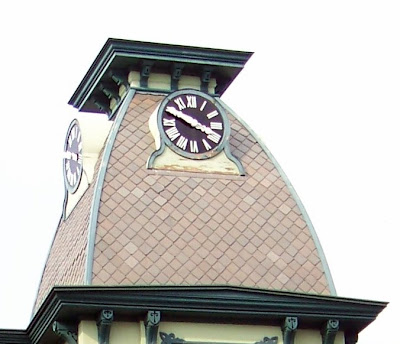
The elegant tower of the N. Bennington train station.
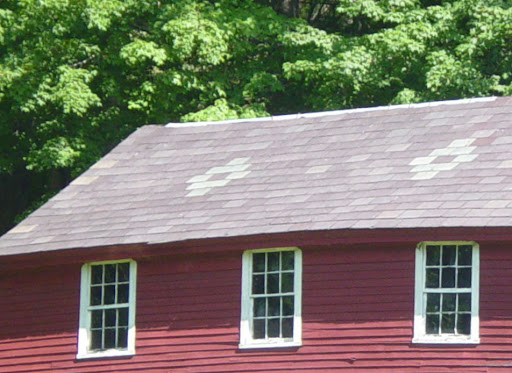
Roof on a barn in Keene, NH - I imagine that when the load of slate arrived, the roofer looked over the color variation in the lot and decided he could make the diamonds.

The pattern on this roof in Pownal, VT, goes all the way around.

A hexagon slate pattern on a warehouse's Mansard roof, by the railroad in Hoosick Falls, NY

A circular tower with round columns, curly Ionic volutes on the capitals, circular slate, and a ball atop the finial - Bennington
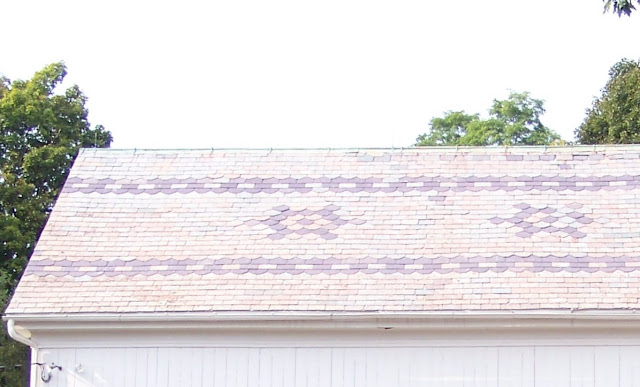
This pattern is on several houses and barns in N. Bennington.
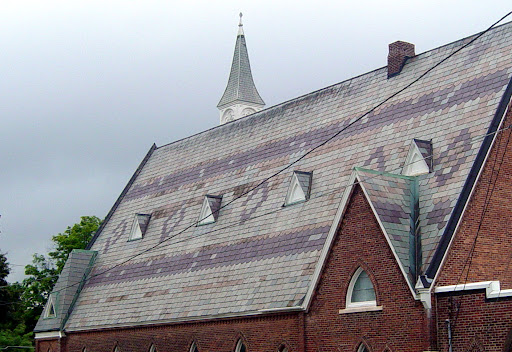 The roof of the Congregational Church in N. Bennington is visible from quite a distance. People passing by on foot or on horseback had plenty of time to enjoy it, but today we whiz past in traffic. I had to take a backstreet so that I could slow down enough to really look.
The roof of the Congregational Church in N. Bennington is visible from quite a distance. People passing by on foot or on horseback had plenty of time to enjoy it, but today we whiz past in traffic. I had to take a backstreet so that I could slow down enough to really look.

Roof of Powers Market, in N. Bennington, and neighbors.
Read Slate Roofs 1: Looking up.
But they are hard to photograph. When I look at a roof with my naked eye, I can see wonderful detail or color, but that often doesn't translate to the picture - if the sun is out, the slate shines, but on a cloudy day, the colors don't show. Photos taken of north sides are best, but some roofs don't face north. Photographing from a distance generally works well, but often trees or houses block my view.
So the photos I've selected to post here may change, as I figure out how to take better pictures.
The Park-McCullough observatory, built in 1864, now missing its iron cresting. Here's a slate roof that is just roofing, while the wood arches, corbels, and brackets are the high points. The Victorian emphasis on surface decoration doesn't come to the fore for another 20 years.
The cupola of the Park-McCullough Stabling, built in 1864. Here the arched vents, the double pitch of the roof, and even the weather vane are more important than the slate.

The elegant tower of the N. Bennington train station.
Roof on a barn in Keene, NH - I imagine that when the load of slate arrived, the roofer looked over the color variation in the lot and decided he could make the diamonds.
The pattern on this roof in Pownal, VT, goes all the way around.
A hexagon slate pattern on a warehouse's Mansard roof, by the railroad in Hoosick Falls, NY
A circular tower with round columns, curly Ionic volutes on the capitals, circular slate, and a ball atop the finial - Bennington

This pattern is on several houses and barns in N. Bennington.

Roof of Powers Market, in N. Bennington, and neighbors.
Read Slate Roofs 1: Looking up.
Saturday, August 9, 2008
Slate Roofs 1: Looking up
Slate roofs are commonplace around Bennington, VT - you find them on mansions, cottages and sheds.
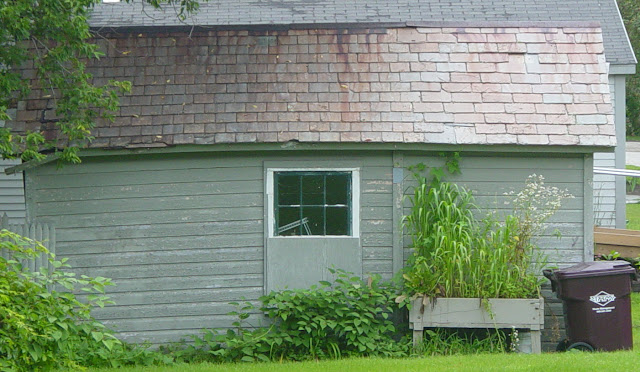
A slate roof on a garage. Many roofs are laid like this, with no pattern.
The history of slate use in Bennington
The slate quarries are just up the railroad line in Rutland County, Vt., and Washington County, NY. From the 1800's to the 1920's, slate was the roof of choice. Slate patterns vary by town. In Bennington, many roofs have the same pattern of curved and straight slate, although the number of scalloped rows may vary.
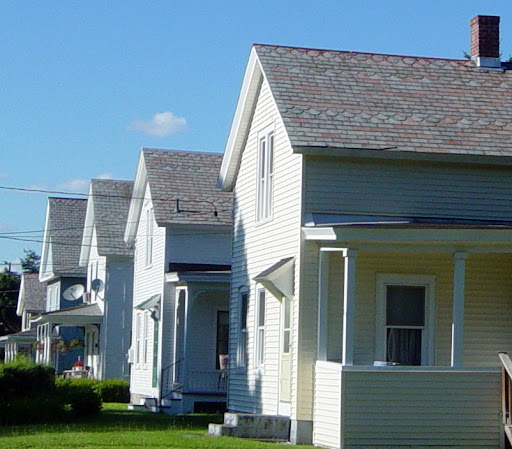
Row of houses for mill workers, with slate roofs using rows of scalloped slate
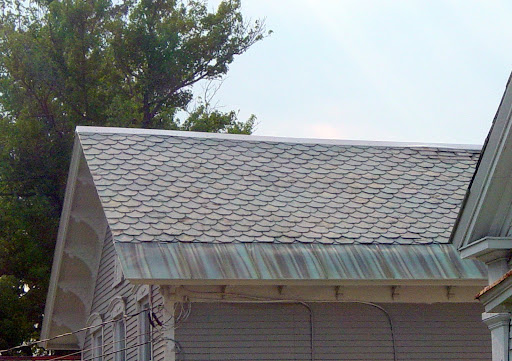
Scalloped shingles become half circles, scales, when that's all there is. This roof is on the same street as the ones shown above.
Brattleboro, Vt. roofers laid their slate in a different pattern, a double overlap:
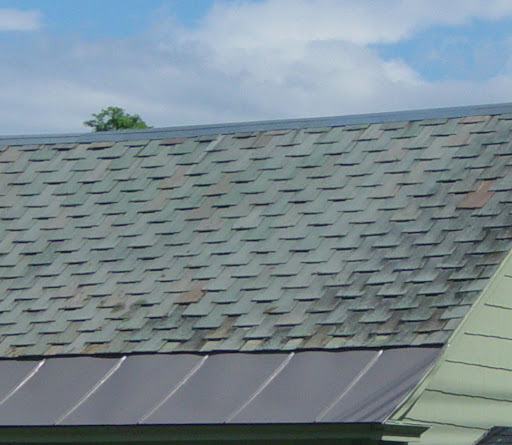
The Creamery Covered Bridge, just off Rte 9 in West Brattleboro, has a double-overlap roof like this one.
Slate is both strong and attractive
Good slate lasts at least 150 years, poor slate only 75 years. The underlayment, flashing, and nails will wear out well before before the stone, so slate pieces were often reused. As an added decorative bonus, slate comes in various colors, and pieces split from the same block will have gradations of color. Different quarries will also have different shades and intensities of a similar color.
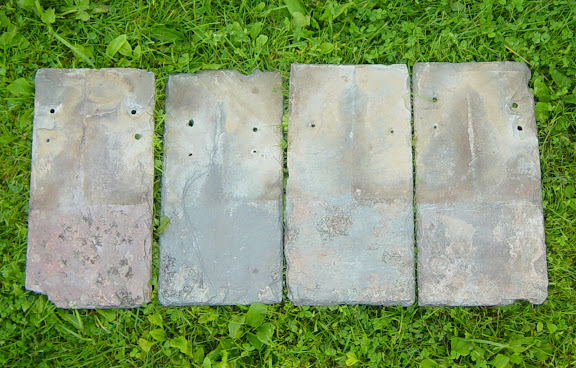 Used slate showing the range of color - even in slate from the same quarry. The gray layer is sloughing off on the furthest left piece, revealing a reddish layer underneath.
Used slate showing the range of color - even in slate from the same quarry. The gray layer is sloughing off on the furthest left piece, revealing a reddish layer underneath.
Note double nail holes on all but one (indicating that those pieces have been used twice) and the vertical lines showing how the next layer of slate was laid upon these. The brown on the top half is dirt, and the little swirls are lichen.
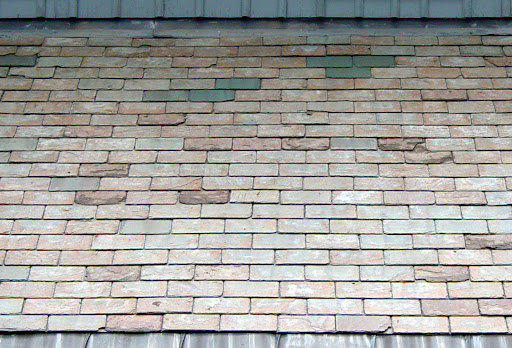 Here are at least 4 different slate colors. The green pieces are probably patches. Some of the darkish red slate is also sloughing off and chipping with age.
Here are at least 4 different slate colors. The green pieces are probably patches. Some of the darkish red slate is also sloughing off and chipping with age.
Red slate has always been in short supply, and is therefore the most expensive. In 1879 three quarries produced red slate, but today there is only one.
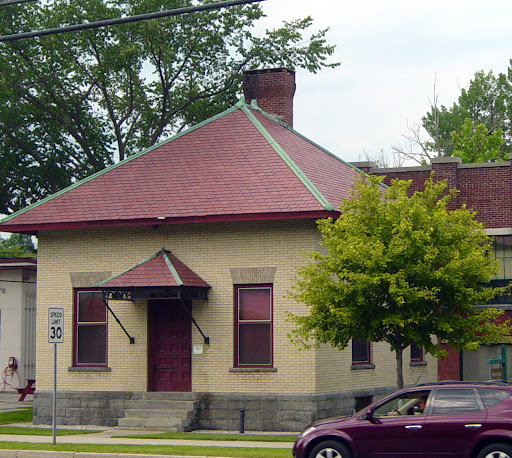
a red slate roof on a company's headquarters
Some owners used slate to create eye-catching roofs, and some roofers had fine imaginations. Some quite simple houses have amazing roofs (Hoosick Falls roof, below) and some amazing mansions have simple roofs (photo at beginning of post).
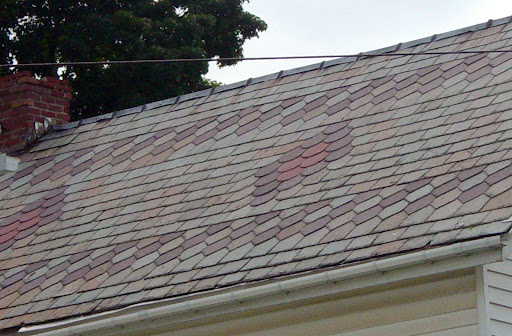 Perfectly placed colors on a roof in Hoosick Falls, NY, with both scallops and hexagons.
Perfectly placed colors on a roof in Hoosick Falls, NY, with both scallops and hexagons.
The hexagon slate was used in Hoosick, but is rare in Bennington, just next door.
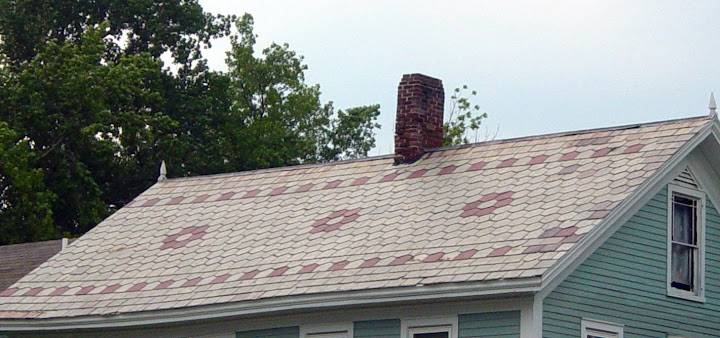
This roof uses the expensive red slate sparingly, for emphasis

The Thatcher House has slate on the walls as well as the roof, and all of it is scalloped.
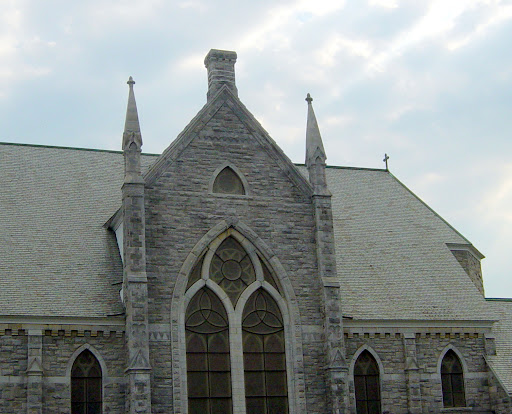
Sometimes only one color is used, from one quarry. Here the church's walls and windows are what's important. The slate roof is a quiet surface, a complimentary color.
The decline of slate use
Beginning in the 1920's, if a slate roof failed it was replaced with asphalt shingles, the 'modern' solution. So the roofers who had installed slate had no reason to pass on their skills, and by the 1970's very few people could lay or repair slate roofs.
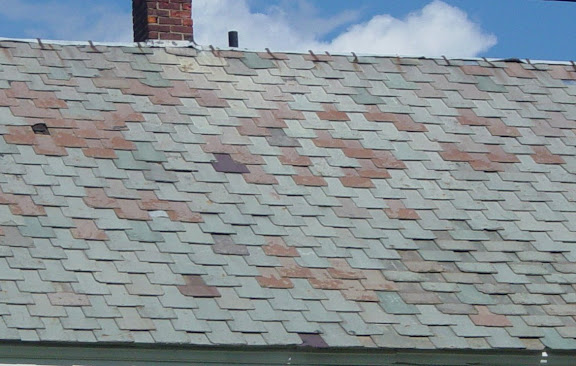
This roof in Brattleboro, may once have had a design, or the reddish slate were used for patching. Some of the slate in the lower right corner do not have enough overlap.
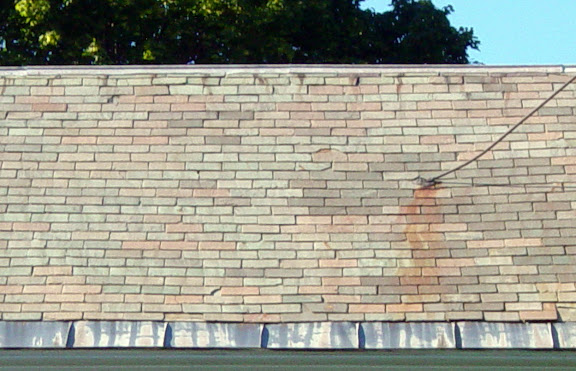
A roof with broken, missing (along the lower edge), and loose slate. The darker slate to the right is a patch.
Today, although we are relearning the old trade, we haven't mastered all the tricks. And sadly, many people don't value their original slate roofs. When I went to photograph an amazing roof for this article, I discovered that it was gone, replaced since I last saw it in the fall by dull, asphalt shingles.
As this post is about the general use of slate, I have left out photos of many delightful local roofs and details. My next post will be a series of neat roofs and towers, just for fun. In the meantime, here is a site and a book for more information:
Slate Valley Museum, in Granville, NY
The Slate Roof Bible, Joseph Jenkins, Jenkins Publishing, Grove City, PA, 2003
Read Slate Roofs 2: the sequel.
A slate roof on a garage. Many roofs are laid like this, with no pattern.
The history of slate use in Bennington
The slate quarries are just up the railroad line in Rutland County, Vt., and Washington County, NY. From the 1800's to the 1920's, slate was the roof of choice. Slate patterns vary by town. In Bennington, many roofs have the same pattern of curved and straight slate, although the number of scalloped rows may vary.
Row of houses for mill workers, with slate roofs using rows of scalloped slate
Scalloped shingles become half circles, scales, when that's all there is. This roof is on the same street as the ones shown above.
Brattleboro, Vt. roofers laid their slate in a different pattern, a double overlap:
The Creamery Covered Bridge, just off Rte 9 in West Brattleboro, has a double-overlap roof like this one.
Slate is both strong and attractive
Good slate lasts at least 150 years, poor slate only 75 years. The underlayment, flashing, and nails will wear out well before before the stone, so slate pieces were often reused. As an added decorative bonus, slate comes in various colors, and pieces split from the same block will have gradations of color. Different quarries will also have different shades and intensities of a similar color.
Note double nail holes on all but one (indicating that those pieces have been used twice) and the vertical lines showing how the next layer of slate was laid upon these. The brown on the top half is dirt, and the little swirls are lichen.
Red slate has always been in short supply, and is therefore the most expensive. In 1879 three quarries produced red slate, but today there is only one.
a red slate roof on a company's headquarters
Some owners used slate to create eye-catching roofs, and some roofers had fine imaginations. Some quite simple houses have amazing roofs (Hoosick Falls roof, below) and some amazing mansions have simple roofs (photo at beginning of post).
The hexagon slate was used in Hoosick, but is rare in Bennington, just next door.
This roof uses the expensive red slate sparingly, for emphasis
The Thatcher House has slate on the walls as well as the roof, and all of it is scalloped.
Sometimes only one color is used, from one quarry. Here the church's walls and windows are what's important. The slate roof is a quiet surface, a complimentary color.
The decline of slate use
Beginning in the 1920's, if a slate roof failed it was replaced with asphalt shingles, the 'modern' solution. So the roofers who had installed slate had no reason to pass on their skills, and by the 1970's very few people could lay or repair slate roofs.
This roof in Brattleboro, may once have had a design, or the reddish slate were used for patching. Some of the slate in the lower right corner do not have enough overlap.
A roof with broken, missing (along the lower edge), and loose slate. The darker slate to the right is a patch.
Today, although we are relearning the old trade, we haven't mastered all the tricks. And sadly, many people don't value their original slate roofs. When I went to photograph an amazing roof for this article, I discovered that it was gone, replaced since I last saw it in the fall by dull, asphalt shingles.
As this post is about the general use of slate, I have left out photos of many delightful local roofs and details. My next post will be a series of neat roofs and towers, just for fun. In the meantime, here is a site and a book for more information:
Slate Valley Museum, in Granville, NY
The Slate Roof Bible, Joseph Jenkins, Jenkins Publishing, Grove City, PA, 2003
Read Slate Roofs 2: the sequel.
Wednesday, June 25, 2008
Building to the weather - what is Original Green?
"Original Green, passive solar, building to the weather."
These are all ways to describe the same thing - how people all over the world have traditionally built to work with their specific climate.
People who look at architecture often see buildings as aesthetic symbols, or evidence of a society's aspirations. Sometimes they see buildings in terms of structure and technology. Often they focus on monuments, places intended for ceremony. Europe's Gothic cathedrals are excellent examples of all those ideas. But buildings are foremost shelter, a place to be inside - protected from the weather, whatever it may be - spaces for living. Even cathedrals had spaces where people lived - cloisters - and often served as informal gathering places.
But our ancestors spent much of their lives outside. They lived without electricity, central heat or air conditioning, so they had to understand their surroundings. They learned how to adapt their buildings to their weather, making their daily lives more comfortable by how they fashioned those buildings. And they did this with no modern technology. Instead, they understood the basic forces: sun, rain, wind - the macro-climate - and their building sites, where topography and geography create specific micro-climates. Their solutions are wonderful, inventive, brilliant. So what I'm saying, is, " Hey, pay attention! This is great stuff! It's all around us, in its marvelous variety. Maybe you are lucky enough to already live in it!"
Read my 7 part series about 'building to the weather' at the Park-McCullough Barn and House
Part 1 - http://www.jgrarchitect.com/2008/04/building-to-weather.html
Part 2 - How does the carriage house work with the sun to minimize wind chill?
http://www.jgrarchitect.com/2008/04/building-to-weather-2.html
Part 3 - Why bother with a cupola?
http://www.jgrarchitect.com/2008/05/thats-pretty-amazing-cupola-with-all.html
Part 4 - Eaves? they're important?
http://www.jgrarchitect.com/2008/05/eaves-for-work-and-play.html
Part 5 - How a floor plan makes a difference:
http://www.jgrarchitect.com/2008/06/no-tech-warmth-with-low-tech-aid.html
Part 6 - A look at how these concepts were used at the Big House:
http://www.jgrarchitect.com/2008/09/big-house-is-green-too.html
Part 7 - Shutters:
http://www.jgrarchitect.com/2008/03/shutters-ok-i-know-that-they-were-for.ht
These are all ways to describe the same thing - how people all over the world have traditionally built to work with their specific climate.
People who look at architecture often see buildings as aesthetic symbols, or evidence of a society's aspirations. Sometimes they see buildings in terms of structure and technology. Often they focus on monuments, places intended for ceremony. Europe's Gothic cathedrals are excellent examples of all those ideas. But buildings are foremost shelter, a place to be inside - protected from the weather, whatever it may be - spaces for living. Even cathedrals had spaces where people lived - cloisters - and often served as informal gathering places.
But our ancestors spent much of their lives outside. They lived without electricity, central heat or air conditioning, so they had to understand their surroundings. They learned how to adapt their buildings to their weather, making their daily lives more comfortable by how they fashioned those buildings. And they did this with no modern technology. Instead, they understood the basic forces: sun, rain, wind - the macro-climate - and their building sites, where topography and geography create specific micro-climates. Their solutions are wonderful, inventive, brilliant. So what I'm saying, is, " Hey, pay attention! This is great stuff! It's all around us, in its marvelous variety. Maybe you are lucky enough to already live in it!"
Read my 7 part series about 'building to the weather' at the Park-McCullough Barn and House
Part 1 - http://www.jgrarchitect.com/2008/04/building-to-weather.html
Part 2 - How does the carriage house work with the sun to minimize wind chill?
http://www.jgrarchitect.com/2008/04/building-to-weather-2.html
Part 3 - Why bother with a cupola?
http://www.jgrarchitect.com/2008/05/thats-pretty-amazing-cupola-with-all.html
Part 4 - Eaves? they're important?
http://www.jgrarchitect.com/2008/05/eaves-for-work-and-play.html
Part 5 - How a floor plan makes a difference:
http://www.jgrarchitect.com/2008/06/no-tech-warmth-with-low-tech-aid.html
Part 6 - A look at how these concepts were used at the Big House:
http://www.jgrarchitect.com/2008/09/big-house-is-green-too.html
Part 7 - Shutters:
http://www.jgrarchitect.com/2008/03/shutters-ok-i-know-that-they-were-for.ht
Sunday, June 1, 2008
Building to the weather - Part 5 of 7: What goes where, a no-tech solution
All over the world people have learned over the centuries how to work with their specific conditions - their macro- and micro- climates. This is the technical definition of 'original green'. I have used the past several posts to detail the design of the Park-McCullough carriage house, to illustrate how the architect worked with the southern Vermont climate, while also creating a visual masterpiece.
This post focuses on the layout of the spaces inside the barn, how they plan works with the weather. Here's the floor plan: South is to the top, north on the bottom, the horse stalls to the west (right side), the front door to the east (left side). The general purpose room is where a horse would have been harnessed to a carriage, while the small bay to the south (top) was for carriages, maybe those needing maintenance. Note than no door opens to the north or west - only toward the mild east or the sunny south. There is a logical, efficient progression of spaces from the horse stalls to the carriages and on to the front door, with stops along the way for harnessing and tack, additions on the sides for staff quarters and repair, and space overhead for hay and grain.
South is to the top, north on the bottom, the horse stalls to the west (right side), the front door to the east (left side). The general purpose room is where a horse would have been harnessed to a carriage, while the small bay to the south (top) was for carriages, maybe those needing maintenance. Note than no door opens to the north or west - only toward the mild east or the sunny south. There is a logical, efficient progression of spaces from the horse stalls to the carriages and on to the front door, with stops along the way for harnessing and tack, additions on the sides for staff quarters and repair, and space overhead for hay and grain.
This building is also designed to maximize the comfort of its occupants all year round - without technology. The long working side of the barn faces south - the previously mentioned spaces for the carriages to be readied for use, as well as the tack room holding leather bridles, saddles, horse paraphernalia. Next comes the store room for harness, and the grooming room with double doors facing south, and then the stable. On the other side of the building, the north side of the main carriage space (holding carriage not in use) can be closed off in winter by 20' long sliding doors. There is a 'people' door (3 ft. wide) between the hall and the north bay bearing Trenor Park's monogram, which speaks to this north side's regular separation from the main bay.
Continuing around the building, the horse stalls on the west end need only small windows set high in the wall, literally 'horse windows' just the right size and height for horses to look out of. Thus, with only a few small openings, the stable also becomes a barrier to the cold west wind in winter, helped in part because the horses' own heat will keep the stable warm, making it a buffer for the main barn.
The two chimneys in the barn serve the rooms designed for people; the grooms' quarters on the north side, and the tack room, on the south. The tack room - a work room - is buffered from the elements by being set in the middle of the building, almost entirely surrounded by the carriage and store rooms. It has a large window for natural light, and the warmth of the winter sun . Even its exterior walls are set in a sun pocket, where they are protected by south and east facing walls. With a coal stove, this room would have been a cozy place to mend tack and talk about horses. The wash room is protected by its location too. It is in the center of the carriage house, beside the tack room, under the hay loft. The water used to wash the carriages drained down the sloped tin floor into the cellar. That water would not have been quite so cold here in the winter, in a room buffered on all sides. Above it all is the hay loft, filled with fabulously good insulation (hay!), which disappears in the summer when it is not needed, and reappears each fall.
Lastly, there are those large carriage house windows, which let in the welcome winter sun shine, and can be opened across from each other in good weather, encouraging breezes. And so we come full circle to my post about the cupola, and how it acts as original air-conditioning.
Here is the whole series:
Part 1 - http://www.jgrarchitect.com/2008/04/building-to-weather.html
Part 2 - How does the carriage house work with the sun to minimize wind chill?
http://www.jgrarchitect.com/2008/04/building-to-weather-2.html
Part 3 - Why bother with a cupola?
http://www.jgrarchitect.com/2008/05/thats-pretty-amazing-cupola-with-all.html
Part 4 - Eaves? they're important?
http://www.jgrarchitect.com/2008/05/eaves-for-work-and-play.html
Part 5 - How a floor plan makes a difference:
http://www.jgrarchitect.com/2008/06/no-tech-warmth-with-low-tech-aid.html
Part 6 - A look at how these concepts were used at the Big House:
http://www.jgrarchitect.com/2008/09/big-house-is-green-too.html
Part 7 - Shutters:
http://www.jgrarchitect.com/2008/03/shutters-ok-i-know-that-they-were-for.ht
This post focuses on the layout of the spaces inside the barn, how they plan works with the weather. Here's the floor plan:
 South is to the top, north on the bottom, the horse stalls to the west (right side), the front door to the east (left side). The general purpose room is where a horse would have been harnessed to a carriage, while the small bay to the south (top) was for carriages, maybe those needing maintenance. Note than no door opens to the north or west - only toward the mild east or the sunny south. There is a logical, efficient progression of spaces from the horse stalls to the carriages and on to the front door, with stops along the way for harnessing and tack, additions on the sides for staff quarters and repair, and space overhead for hay and grain.
South is to the top, north on the bottom, the horse stalls to the west (right side), the front door to the east (left side). The general purpose room is where a horse would have been harnessed to a carriage, while the small bay to the south (top) was for carriages, maybe those needing maintenance. Note than no door opens to the north or west - only toward the mild east or the sunny south. There is a logical, efficient progression of spaces from the horse stalls to the carriages and on to the front door, with stops along the way for harnessing and tack, additions on the sides for staff quarters and repair, and space overhead for hay and grain.This building is also designed to maximize the comfort of its occupants all year round - without technology. The long working side of the barn faces south - the previously mentioned spaces for the carriages to be readied for use, as well as the tack room holding leather bridles, saddles, horse paraphernalia. Next comes the store room for harness, and the grooming room with double doors facing south, and then the stable. On the other side of the building, the north side of the main carriage space (holding carriage not in use) can be closed off in winter by 20' long sliding doors. There is a 'people' door (3 ft. wide) between the hall and the north bay bearing Trenor Park's monogram, which speaks to this north side's regular separation from the main bay.
Continuing around the building, the horse stalls on the west end need only small windows set high in the wall, literally 'horse windows' just the right size and height for horses to look out of. Thus, with only a few small openings, the stable also becomes a barrier to the cold west wind in winter, helped in part because the horses' own heat will keep the stable warm, making it a buffer for the main barn.
The two chimneys in the barn serve the rooms designed for people; the grooms' quarters on the north side, and the tack room, on the south. The tack room - a work room - is buffered from the elements by being set in the middle of the building, almost entirely surrounded by the carriage and store rooms. It has a large window for natural light, and the warmth of the winter sun . Even its exterior walls are set in a sun pocket, where they are protected by south and east facing walls. With a coal stove, this room would have been a cozy place to mend tack and talk about horses. The wash room is protected by its location too. It is in the center of the carriage house, beside the tack room, under the hay loft. The water used to wash the carriages drained down the sloped tin floor into the cellar. That water would not have been quite so cold here in the winter, in a room buffered on all sides. Above it all is the hay loft, filled with fabulously good insulation (hay!), which disappears in the summer when it is not needed, and reappears each fall.
Lastly, there are those large carriage house windows, which let in the welcome winter sun shine, and can be opened across from each other in good weather, encouraging breezes. And so we come full circle to my post about the cupola, and how it acts as original air-conditioning.
Here is the whole series:
Part 1 - http://www.jgrarchitect.com/2008/04/building-to-weather.html
Part 2 - How does the carriage house work with the sun to minimize wind chill?
http://www.jgrarchitect.com/2008/04/building-to-weather-2.html
Part 3 - Why bother with a cupola?
http://www.jgrarchitect.com/2008/05/thats-pretty-amazing-cupola-with-all.html
Part 4 - Eaves? they're important?
http://www.jgrarchitect.com/2008/05/eaves-for-work-and-play.html
Part 5 - How a floor plan makes a difference:
http://www.jgrarchitect.com/2008/06/no-tech-warmth-with-low-tech-aid.html
Part 6 - A look at how these concepts were used at the Big House:
http://www.jgrarchitect.com/2008/09/big-house-is-green-too.html
Part 7 - Shutters:
http://www.jgrarchitect.com/2008/03/shutters-ok-i-know-that-they-were-for.ht
Thursday, May 22, 2008
Building to the Weather - Part 4 of 7: Eaves, at work and play
Eaves do very important work.
From a practical perspective, they help to keep the rain water that drips off of a building's roof away from its walls. Water on the walls will become trapped water inside the walls, which quickly leads to mildew, mold, and rot. Similarly, eaves keep icicles from forming directly on a building's outer walls (an icicle on the wall can become an icicle dripping down the wall, leading again to water inside the wall).

Eaves that stick out 6" are just barely deep enough to keep rain off; a 9"-12" overhang is better. The Carriage House eaves shown here are 18" deep. Copper gutters - now worn out and removed - originally sat in the curved brackets running along the edge, adding 4" more depth as well as redirecting the water.
Eaves are also for play, of course - they make the carriage house fun to look at. And without eaves, this building would just be an awkward box with bumps. The length of the eaves, their edge moldings, and the rows of brackets underneath all come together to create a roof that visually shelters what's inside and delights the eye. The corbels facing both ways at the ends of the dormer windows and the at the barn's cornerssee the first photo) are just frosting on the cake.
 The eaves here have another job - quite visible in the second picture. This is the south view of the western end of the barn - the eaves keep the summer sun from shining in the windows. This photograph was taken in early May, when the shadow line of the eaves is below the small windows in the stable - the sun will not shine in these windows again until late August. With the extra 4"of gutter, the windows would be shaded earlier and later in the year. Because the sun's path across the sky changes with the seasons (due to the Earth's tilt and rotation around the sun), in winter the sun will be low enough in the sky to shine below the eaves, and into those windows, bringing light and heat to the space inside.
The eaves here have another job - quite visible in the second picture. This is the south view of the western end of the barn - the eaves keep the summer sun from shining in the windows. This photograph was taken in early May, when the shadow line of the eaves is below the small windows in the stable - the sun will not shine in these windows again until late August. With the extra 4"of gutter, the windows would be shaded earlier and later in the year. Because the sun's path across the sky changes with the seasons (due to the Earth's tilt and rotation around the sun), in winter the sun will be low enough in the sky to shine below the eaves, and into those windows, bringing light and heat to the space inside.
That's a lot of creative 'green' stuff for an ordinary building detail to do.
Here is the whole series:
Part 1 - http://www.jgrarchitect.com/2008/04/building-to-weather.html
Part 2 - How does the carriage house work with the sun to minimize wind chill?
http://www.jgrarchitect.com/2008/04/building-to-weather-2.html
Part 3 - Why bother with a cupola?
http://www.jgrarchitect.com/2008/05/thats-pretty-amazing-cupola-with-all.html
Part 4 - Eaves? they're important?
http://www.jgrarchitect.com/2008/05/eaves-for-work-and-play.html
Part 5 - How a floor plan makes a difference:
http://www.jgrarchitect.com/2008/06/no-tech-warmth-with-low-tech-aid.html
Part 6 - A look at how these concepts were used at the Big House:
http://www.jgrarchitect.com/2008/09/big-house-is-green-too.html
Part 7 - Shutters:
http://www.jgrarchitect.com/2008/03/shutters-ok-i-know-that-they-were-for.ht
Read Building to the Weather - Part 3.
Read
From a practical perspective, they help to keep the rain water that drips off of a building's roof away from its walls. Water on the walls will become trapped water inside the walls, which quickly leads to mildew, mold, and rot. Similarly, eaves keep icicles from forming directly on a building's outer walls (an icicle on the wall can become an icicle dripping down the wall, leading again to water inside the wall).

Eaves that stick out 6" are just barely deep enough to keep rain off; a 9"-12" overhang is better. The Carriage House eaves shown here are 18" deep. Copper gutters - now worn out and removed - originally sat in the curved brackets running along the edge, adding 4" more depth as well as redirecting the water.
Eaves are also for play, of course - they make the carriage house fun to look at. And without eaves, this building would just be an awkward box with bumps. The length of the eaves, their edge moldings, and the rows of brackets underneath all come together to create a roof that visually shelters what's inside and delights the eye. The corbels facing both ways at the ends of the dormer windows and the at the barn's cornerssee the first photo) are just frosting on the cake.
 The eaves here have another job - quite visible in the second picture. This is the south view of the western end of the barn - the eaves keep the summer sun from shining in the windows. This photograph was taken in early May, when the shadow line of the eaves is below the small windows in the stable - the sun will not shine in these windows again until late August. With the extra 4"of gutter, the windows would be shaded earlier and later in the year. Because the sun's path across the sky changes with the seasons (due to the Earth's tilt and rotation around the sun), in winter the sun will be low enough in the sky to shine below the eaves, and into those windows, bringing light and heat to the space inside.
The eaves here have another job - quite visible in the second picture. This is the south view of the western end of the barn - the eaves keep the summer sun from shining in the windows. This photograph was taken in early May, when the shadow line of the eaves is below the small windows in the stable - the sun will not shine in these windows again until late August. With the extra 4"of gutter, the windows would be shaded earlier and later in the year. Because the sun's path across the sky changes with the seasons (due to the Earth's tilt and rotation around the sun), in winter the sun will be low enough in the sky to shine below the eaves, and into those windows, bringing light and heat to the space inside.That's a lot of creative 'green' stuff for an ordinary building detail to do.
Here is the whole series:
Part 1 - http://www.jgrarchitect.com/2008/04/building-to-weather.html
Part 2 - How does the carriage house work with the sun to minimize wind chill?
http://www.jgrarchitect.com/2008/04/building-to-weather-2.html
Part 3 - Why bother with a cupola?
http://www.jgrarchitect.com/2008/05/thats-pretty-amazing-cupola-with-all.html
Part 4 - Eaves? they're important?
http://www.jgrarchitect.com/2008/05/eaves-for-work-and-play.html
Part 5 - How a floor plan makes a difference:
http://www.jgrarchitect.com/2008/06/no-tech-warmth-with-low-tech-aid.html
Part 6 - A look at how these concepts were used at the Big House:
http://www.jgrarchitect.com/2008/09/big-house-is-green-too.html
Part 7 - Shutters:
http://www.jgrarchitect.com/2008/03/shutters-ok-i-know-that-they-were-for.ht
Read Building to the Weather - Part 3.
Read
Sunday, May 11, 2008
Building to the weather - Part 3 of 7: Original AC, or how to keep your barn from burning up, and your horses cool

What a great architectural flourish at the top of the Park-McCullough carriage barn! An amazing cupola - with all its roof angles and arched vents.
It's also an important part of the cooling system. A vent at the top of a hay barn is essential: stored hay gets hot - hot enough to burst into flame. The vents let that heat escape out into the air.
They also help to keep the barn cool for people. Heat rises, so if there is an opening at the top of a building warm air trapped inside will escape. As that warm air goes out, replacement air has to come in from someplace else. If there is an opening - a door or window - lower down in the building, new, cooler air will flow in. If the vent at the top is smaller than the opening below, the amount of air coming in is greater than the amount that can easily go out. And more air wants to come in behind it! The air going out has to rush making a breeze.
In the summer, when the windows are open and the doors to the hay loft are open, a breeze will keep the carriage house, the workmen, and the horses cool.
Here is the whole series:
Part 1 - http://www.jgrarchitect.com/2008/04/building-to-weather.html
Part 2 - How does the carriage house work with the sun to minimize wind chill?
http://www.jgrarchitect.com/2008/04/building-to-weather-2.html
Part 3 - Why bother with a cupola?
http://www.jgrarchitect.com/2008/05/thats-pretty-amazing-cupola-with-all.html
Part 4 - Eaves? they're important?
http://www.jgrarchitect.com/2008/05/eaves-for-work-and-play.html
Part 5 - How a floor plan makes a difference:
http://www.jgrarchitect.com/2008/06/no-tech-warmth-with-low-tech-aid.html
Part 6 - A look at how these concepts were used at the Big House:
http://www.jgrarchitect.com/2008/09/big-house-is-green-too.html
Part 7 - Shutters:
http://www.jgrarchitect.com/2008/03/shutters-ok-i-know-that-they-were-for.ht
Monday, April 28, 2008
Building to the weather - Part 2 of 7: Creating a sun pocket

Here is the main facade of the Park-McCullough House Carriage Barn.
As I wrote in the previous post, it faces east, away from prevailing winds and into the morning sun. Notice that the door - a huge door wide enough for carriages and horses - is set back. This is partly so that the hay door above is easily accessible for hay wagons - they can be parked underneath and unloaded. The recessed space also protects against the wind and gathers the sun, making a pocket of warmth. Gardeners know that sheltered sunny nook where the first daffodils will bloom; this recessed entry creates a sheltered sunny place for horses and people.
Many buildings have a double entry that functions like an air lock: one enters through a set of doors into a little vestibule, closes those doors, then opens another set of doors to enter the main space. It's a way to keep cold air out of a warm space (and vice versa when there is air-conditioning.)
A double entry on a barn is not practical. Imagine how big the airlock would need to be for a carriage with horses! This recessed entry is a pretty good substitute - the doors can be opened without the wind rushing in, and on a sunny day in winter, heat may even come in.
Here is the whole series:
Part 1 - http://www.jgrarchitect.com/2008/04/building-to-weather.html
Part 2 - How does the carriage house work with the sun to minimize wind chill?
http://www.jgrarchitect.com/2008/04/building-to-weather-2.html
Part 3 - Why bother with a cupola?
http://www.jgrarchitect.com/2008/05/thats-pretty-amazing-cupola-with-all.html
Part 4 - Eaves? they're important?
http://www.jgrarchitect.com/2008/05/eaves-for-work-and-play.html
Part 5 - How a floor plan makes a difference:
http://www.jgrarchitect.com/2008/06/no-tech-warmth-with-low-tech-aid.html
Part 6 - A look at how these concepts were used at the Big House:
http://www.jgrarchitect.com/2008/09/big-house-is-green-too.html
Part 7 - Shutters:
http://www.jgrarchitect.com/2008/03/shutters-ok-i-know-that-they-were-for.ht
Building to the weather - Part 1 of 7: Maximizing sun exposure
 What does it mean to 'build to the weather'?
What does it mean to 'build to the weather'?Look at this 1864 barn, the Park-McCullough House Carriage House, designed by an architect for a very wealthy family. A working stable - people and horses lived in it year round. It had very little heat: a stove in the tack room, another in the living quarters. However, its use of natural forces for winter warmth and summer cooling were quite effective. The techniques can be seen in many other barns built for ordinary farmers.
There was plenty of land - the barn could have been sited and organized in many different ways. Architecturally, it was placed visually to compliment the House, sitting just beyond it and framing the lawn. The main facade looked back to the House (and the flower garden and pond, which are no longer there). add another photograph of the House and barn together
The architect considered the climate. He understood how to work with the sun. He set the long side of the barn to face due south for maximum sunshine - technically called 'solar gain'. The east end, the front, would get morning sun; the south side, sun all day; the west side, afternoon sun; and the north side, a brief bit of sun only in mid-summer. He knew that in this part of western Vermont the wind blows mainly from the west, sometimes from the north. Wind is good for cooling in the summer, but makes things colder in the winter - technically called 'wind chill'.
Here's the whole series:
Part 1 - http://www.jgrarchitect.com/2008/04/building-to-weather.html
Part 2 - How does the carriage house work with the sun to minimize wind chill?
http://www.jgrarchitect.com/2008/04/building-to-weather-2.html
Part 3 - Why bother with a cupola?
http://www.jgrarchitect.com/2008/05/thats-pretty-amazing-cupola-with-all.html
Part 4 - Eaves? they're important?
http://www.jgrarchitect.com/2008/05/eaves-for-work-and-play.html
Part 5 - How a floor plan makes a difference:
http://www.jgrarchitect.com/2008/06/no-tech-warmth-with-low-tech-aid.html
Part 6 - A look at how these concepts were used at the Big House:
http://www.jgrarchitect.com/2008/09/big-house-is-green-too.html
Part 7 - Shutters:
http://www.jgrarchitect.com/2008/03/shutters-ok-i-know-that-they-were-for.ht
Tuesday, April 15, 2008
Buildings of interest 1: Norton-Fenton House, Pleasant St, Bennington VT

In 1838, Luman Norton, owner of the Norton Pottery, moved down the hill from the Old Center of Bennington to live on Pleasant Street, to be near his factory on the Wolloomsac River. He now needed a 2 family house. He had recently been appointed a judge, and opened a second factory to manufacture firebrick (the kind used in the backs of fireplaces and in refractories). His son-in-law, Christopher Fenton, ran the pottery factory, so it made sense that the two families live side by side. However, the new house needed to be more than just a 2 family house with its multiple doors and chimneys. Norton required a residence worthy of a successful manufacturer, and a judge.
 Here is what he built: a brick house with a grand, 2 story tall, porch framed by columns and a pediment (the triangle that sits above the columns), with a broad frieze board across the top, right up under the roof, bright white against the red brick . The columns he used are ‘ionic’, the style favored in the Old Center of Bennington. Ionic capitals, with those curved horns on the top, were seen as symbols for virtue and wisdom. His front doors and sidelights - now almost invisible under the little porches - repeat the details.
Here is what he built: a brick house with a grand, 2 story tall, porch framed by columns and a pediment (the triangle that sits above the columns), with a broad frieze board across the top, right up under the roof, bright white against the red brick . The columns he used are ‘ionic’, the style favored in the Old Center of Bennington. Ionic capitals, with those curved horns on the top, were seen as symbols for virtue and wisdom. His front doors and sidelights - now almost invisible under the little porches - repeat the details. On the ends, the brick walls step up above the roof , include the chimneys, and visually enlarge the house. These walls are structural, 3 bricks thick. They are laid in the pattern called Flemish Bond, which is one of the most difficult to lay neatly. The bricks placed on end - called ‘headers’, because when the wall is finished you see the end, or the 'head' of the brick - tie the rows of brick together. In Flemish Bond, every layer has headers. If the work isn’t done with great care, it isn’t neat. This is very neat and handsome work, because Norton could afford the best.
On the ends, the brick walls step up above the roof , include the chimneys, and visually enlarge the house. These walls are structural, 3 bricks thick. They are laid in the pattern called Flemish Bond, which is one of the most difficult to lay neatly. The bricks placed on end - called ‘headers’, because when the wall is finished you see the end, or the 'head' of the brick - tie the rows of brick together. In Flemish Bond, every layer has headers. If the work isn’t done with great care, it isn’t neat. This is very neat and handsome work, because Norton could afford the best.All the parts, the 3 strong columns right there in the center of the front, the white trim, and the tall brick ends make this 2 family house into an imposing residence. Norton used the normal materials of the time - brick, wood, stone - and details well known in the Old Center -Ionic columns, pediments, friezes. His house, one of the first built below the hill by a successful Benningtonian, combined them in a way that had not been done before. Norton built in a new fashion in the new center of Bennington.
Monday, April 7, 2008
A note on why I'm blogging
Architecture and construction are governed by changes in technology - style comes about after the change in how we can build. I have seen the changes caused by the end of old growth lumber and the introduction of engineered lumber. I remember when the first machine that could cut granite counter tops was set up in town. I saw how the ability to make inexpensive mouldings out of finger-jointed wood or mdf changed window and door casings, and changed our clients' expectations. So I want to think about how the development of technology we now take for granted (wire screens) or see as eye candy ( shutters) has impacted design. And how people were inventive as they came to understand what the technology could do.
When I give the tour at the Historic Park-McCullough House, and I talk about this stuff, people are fascinated - they love knowing how The House works. So I need to be accurate, not just hypothesizing.
I'm also interested because screens and shutters are examples of green technology and design. They can be made from renewable resources. They don't use fossil fuel to operate. They can be adjusted for the weather. They can be repaired without fancy tools. And they will not be obsolete because 'they' don't make the part anymore.
 I also love to learn about how people have interacted with their spaces. I share the enthusiasm of the visitors to The House - I think it's fun to imagine being the first person to turn a sieve upside down and recognize that it could keep flies off the food. Or to realize that, of course, mosquitoes don't bite when there's a breeze, so how do we make a breeze?
I also love to learn about how people have interacted with their spaces. I share the enthusiasm of the visitors to The House - I think it's fun to imagine being the first person to turn a sieve upside down and recognize that it could keep flies off the food. Or to realize that, of course, mosquitoes don't bite when there's a breeze, so how do we make a breeze?
When I give the tour at the Historic Park-McCullough House, and I talk about this stuff, people are fascinated - they love knowing how The House works. So I need to be accurate, not just hypothesizing.
I'm also interested because screens and shutters are examples of green technology and design. They can be made from renewable resources. They don't use fossil fuel to operate. They can be adjusted for the weather. They can be repaired without fancy tools. And they will not be obsolete because 'they' don't make the part anymore.
 I also love to learn about how people have interacted with their spaces. I share the enthusiasm of the visitors to The House - I think it's fun to imagine being the first person to turn a sieve upside down and recognize that it could keep flies off the food. Or to realize that, of course, mosquitoes don't bite when there's a breeze, so how do we make a breeze?
I also love to learn about how people have interacted with their spaces. I share the enthusiasm of the visitors to The House - I think it's fun to imagine being the first person to turn a sieve upside down and recognize that it could keep flies off the food. Or to realize that, of course, mosquitoes don't bite when there's a breeze, so how do we make a breeze?
Sunday, March 30, 2008
Screens - a quick history
As I wrote the first draft for this, the chickens were complaining about the snow. They don't like to step in it, and shake their toes. It covered the ground where they scratch. We are all ready for spring, and screens!
This post on screens is a follow-up to the post on shutters. They are related in that as screens become popular, the use of shutters declined.
 The Park-McCullough House has half screens that are a later addition (or at least the fasteners do not date to 1864) to the windows. Trenor Park used the latest technology when he built his house in 1864. Did he specify screens? We haven't seen any references in our archives. The House has a extensive collection of photographs, but I know of no early pictures with screens on windows in the background.
The Park-McCullough House has half screens that are a later addition (or at least the fasteners do not date to 1864) to the windows. Trenor Park used the latest technology when he built his house in 1864. Did he specify screens? We haven't seen any references in our archives. The House has a extensive collection of photographs, but I know of no early pictures with screens on windows in the background.
So, when might the family have added screens? My usual first stops are Victorian Interior Decoration, Winkler and Moss, for general history, and then the pattern books, mill work catalogs, and the Sears Roebuck and Montgomery Ward catalogs. The pattern books may be promoting a new idea; when something is in the catalogs, it's an accepted part of the culture.
 VID has a wonderful picture of horrible mosquitoes in an 1885 ad , as well as ads for mosquito netting over beds from the 1840's to the 1890's. The picture of the embroidered screen doors above comes from the 1893 catalog of the Mulliner Box & Planing Co., (republished by Dover in 1995). The 1895 Ward catalog shows similar screen doors and sells screening for do-it-yourself-ers.
VID has a wonderful picture of horrible mosquitoes in an 1885 ad , as well as ads for mosquito netting over beds from the 1840's to the 1890's. The picture of the embroidered screen doors above comes from the 1893 catalog of the Mulliner Box & Planing Co., (republished by Dover in 1995). The 1895 Ward catalog shows similar screen doors and sells screening for do-it-yourself-ers.
I know from my own work (as an architect) that sun porches sprout on houses in great numbers in New England around 1900 - glassed-in new and existing porches, with screens stored close by for summer use. Screen porches are standard features by the 1920's. But they don't appear in the pattern books. Was the public ahead of the designers?
I think technology is a deciding factor. When could we manufacture screening? The research I have found says the English made 'wire gauze' as early as the 1830's. American companies who made screening for sieves, made screens too by the late 1850's. The US made screens were used mainly to cover food from flies - upside down sieves! (The weave was not fine enough to keep out mosquitoes.)
The US made screens were used mainly to cover food from flies - upside down sieves! (The weave was not fine enough to keep out mosquitoes.)
However, the Justin Smith Morril Homestead in Strafford Village, Vermont (built in the early 185o's, enlarged in 1859) has screens which may be original. The early screens were painted because the iron mesh would rust, and may have been used for privacy, rather than to keep out flying things. 'Wire cloth' needed to be finely woven to keep out mosquitoes, then it needed to be inexpensive. That seems to have happened in 1876 when a patent was issued for a power loom to weave screening - to Mr. Wickwire of Cortlandt, NY. (What a great name!) The quantity of screening produced in the US increased more than10 fold in the next 20 years.
The Park-McCullough House has screen panels in various states of repair in the basement. (The family saved everything.) Maybe they can be dated.
A great resource here was '100 Years of American Commerce, 1795-1895, edited by Chauncey M. Depew which I found reprinted on-line by Google Booksearch.
This post on screens is a follow-up to the post on shutters. They are related in that as screens become popular, the use of shutters declined.
 The Park-McCullough House has half screens that are a later addition (or at least the fasteners do not date to 1864) to the windows. Trenor Park used the latest technology when he built his house in 1864. Did he specify screens? We haven't seen any references in our archives. The House has a extensive collection of photographs, but I know of no early pictures with screens on windows in the background.
The Park-McCullough House has half screens that are a later addition (or at least the fasteners do not date to 1864) to the windows. Trenor Park used the latest technology when he built his house in 1864. Did he specify screens? We haven't seen any references in our archives. The House has a extensive collection of photographs, but I know of no early pictures with screens on windows in the background.So, when might the family have added screens? My usual first stops are Victorian Interior Decoration, Winkler and Moss, for general history, and then the pattern books, mill work catalogs, and the Sears Roebuck and Montgomery Ward catalogs. The pattern books may be promoting a new idea; when something is in the catalogs, it's an accepted part of the culture.
 VID has a wonderful picture of horrible mosquitoes in an 1885 ad , as well as ads for mosquito netting over beds from the 1840's to the 1890's. The picture of the embroidered screen doors above comes from the 1893 catalog of the Mulliner Box & Planing Co., (republished by Dover in 1995). The 1895 Ward catalog shows similar screen doors and sells screening for do-it-yourself-ers.
VID has a wonderful picture of horrible mosquitoes in an 1885 ad , as well as ads for mosquito netting over beds from the 1840's to the 1890's. The picture of the embroidered screen doors above comes from the 1893 catalog of the Mulliner Box & Planing Co., (republished by Dover in 1995). The 1895 Ward catalog shows similar screen doors and sells screening for do-it-yourself-ers.I know from my own work (as an architect) that sun porches sprout on houses in great numbers in New England around 1900 - glassed-in new and existing porches, with screens stored close by for summer use. Screen porches are standard features by the 1920's. But they don't appear in the pattern books. Was the public ahead of the designers?
I think technology is a deciding factor. When could we manufacture screening? The research I have found says the English made 'wire gauze' as early as the 1830's. American companies who made screening for sieves, made screens too by the late 1850's.
 The US made screens were used mainly to cover food from flies - upside down sieves! (The weave was not fine enough to keep out mosquitoes.)
The US made screens were used mainly to cover food from flies - upside down sieves! (The weave was not fine enough to keep out mosquitoes.)However, the Justin Smith Morril Homestead in Strafford Village, Vermont (built in the early 185o's, enlarged in 1859) has screens which may be original. The early screens were painted because the iron mesh would rust, and may have been used for privacy, rather than to keep out flying things. 'Wire cloth' needed to be finely woven to keep out mosquitoes, then it needed to be inexpensive. That seems to have happened in 1876 when a patent was issued for a power loom to weave screening - to Mr. Wickwire of Cortlandt, NY. (What a great name!) The quantity of screening produced in the US increased more than10 fold in the next 20 years.
The Park-McCullough House has screen panels in various states of repair in the basement. (The family saved everything.) Maybe they can be dated.
A great resource here was '100 Years of American Commerce, 1795-1895, edited by Chauncey M. Depew which I found reprinted on-line by Google Booksearch.
Tuesday, March 18, 2008
Building to the weather:Part 7 of 7 - Whys and Wherefores of Shutters
OK, I know that they were for protection - you closed up the house when you went away, or against a coming storm. Or they kept out the cold - 'Indian shutters', which came about after the Revolution, were not to protect against Indians, but for warmth in winter, 'coolth' in the summer, and for visual privacy from the street. And I know that our ancestors closed in their houses because they considered 'night air' dangerous.
I also know that 1) most houses were designed with windows directly opposite each other to encourage air flow, 2) in climates warmer than the north east, the kitchen was completely open in the summer - hence the 'dutch' door, where the bottom part keep animals out and small children in.
But as soon as the circular saw allowed us to make fins, shutters became popular in a way that they hadn't been before - they become standard equipment. And then it's not until the 1920's that they become decorative, with little cut-outs on the upper panels.
Why? Are the reasons I've listed enough? I have read that the shutters protected fabric from fading, that a dark interior was fashionable. I am still skeptical, I think these are secondary benefits. The Park-McCullough House has movable interior shutters on all windows, even in the servants' wing. It also has, as original equipment, louvered doors as second doors from the bedrooms in the main house into the upstairs hall (which is a room about 14' wide and 50' long). The House also has a belvedere, (a tower in the center of the house for surveying the beautiful countryside) which even today in the summer easily cools the House. The scientific principal behind it is called a Venturi.
I was recently reminded that mosquitoes do not bite when there is a breeze. I also know that the technology to make windows screens that could protect against mosquitoes was not really available until the 1890's. ( It has to do with weaving fine wire mesh .)
Then I thought about how in the evening the heat of the day could escape out the top of the house, bringing the cool air in from below, and keep the mosquitoes moving. And provide privacy...
I think I've got it!
References:
Victorian Interior Decoration, Winkler and Moss, Henry Holt, NY,1986
How Night Air Became Good Air,1776-1930, Baldwin,
Environmental History, Vol. 8, Issue 3
and conversations with John Crosby Freeman, "The Color Doctor"
Here is the whole series:
Part 1 - http://www.jgrarchitect.com/2008/04/building-to-weather.html
Part 2 - How does the carriage house work with the sun to minimize wind chill?
http://www.jgrarchitect.com/2008/04/building-to-weather-2.html
Part 3 - Why bother with a cupola?
http://www.jgrarchitect.com/2008/05/thats-pretty-amazing-cupola-with-all.html
Part 4 - Eaves? they're important?
http://www.jgrarchitect.com/2008/05/eaves-for-work-and-play.html
Part 5 - How a floor plan makes a difference:
http://www.jgrarchitect.com/2008/06/no-tech-warmth-with-low-tech-aid.html
Part 6 - A look at how these concepts were used at the Big House:
http://www.jgrarchitect.com/2008/09/big-house-is-green-too.html
Part 7 - Shutters:
http://www.jgrarchitect.com/2008/03/shutters-ok-i-know-that-they-were-for.ht
I also know that 1) most houses were designed with windows directly opposite each other to encourage air flow, 2) in climates warmer than the north east, the kitchen was completely open in the summer - hence the 'dutch' door, where the bottom part keep animals out and small children in.
But as soon as the circular saw allowed us to make fins, shutters became popular in a way that they hadn't been before - they become standard equipment. And then it's not until the 1920's that they become decorative, with little cut-outs on the upper panels.
Why? Are the reasons I've listed enough? I have read that the shutters protected fabric from fading, that a dark interior was fashionable. I am still skeptical, I think these are secondary benefits. The Park-McCullough House has movable interior shutters on all windows, even in the servants' wing. It also has, as original equipment, louvered doors as second doors from the bedrooms in the main house into the upstairs hall (which is a room about 14' wide and 50' long). The House also has a belvedere, (a tower in the center of the house for surveying the beautiful countryside) which even today in the summer easily cools the House. The scientific principal behind it is called a Venturi.
I was recently reminded that mosquitoes do not bite when there is a breeze. I also know that the technology to make windows screens that could protect against mosquitoes was not really available until the 1890's. ( It has to do with weaving fine wire mesh .)
Then I thought about how in the evening the heat of the day could escape out the top of the house, bringing the cool air in from below, and keep the mosquitoes moving. And provide privacy...
I think I've got it!
References:
Victorian Interior Decoration, Winkler and Moss, Henry Holt, NY,1986
How Night Air Became Good Air,1776-1930, Baldwin,
Environmental History, Vol. 8, Issue 3
and conversations with John Crosby Freeman, "The Color Doctor"
Here is the whole series:
Part 1 - http://www.jgrarchitect.com/2008/04/building-to-weather.html
Part 2 - How does the carriage house work with the sun to minimize wind chill?
http://www.jgrarchitect.com/2008/04/building-to-weather-2.html
Part 3 - Why bother with a cupola?
http://www.jgrarchitect.com/2008/05/thats-pretty-amazing-cupola-with-all.html
Part 4 - Eaves? they're important?
http://www.jgrarchitect.com/2008/05/eaves-for-work-and-play.html
Part 5 - How a floor plan makes a difference:
http://www.jgrarchitect.com/2008/06/no-tech-warmth-with-low-tech-aid.html
Part 6 - A look at how these concepts were used at the Big House:
http://www.jgrarchitect.com/2008/09/big-house-is-green-too.html
Part 7 - Shutters:
http://www.jgrarchitect.com/2008/03/shutters-ok-i-know-that-they-were-for.ht
Friday, February 29, 2008
Neither Batty nor Swan!
 This is a photo of the mouldings in my house, which look so much like the ones used in the Robert E. Lee house, in Arlington VA. I thought it would be an easy matter to matching this moulding pattern to an illustration in a pattern book - I assumed that I'd simply look in the books that the American builders (joiners) were using in about 1800, find the right page, and there it would be.
This is a photo of the mouldings in my house, which look so much like the ones used in the Robert E. Lee house, in Arlington VA. I thought it would be an easy matter to matching this moulding pattern to an illustration in a pattern book - I assumed that I'd simply look in the books that the American builders (joiners) were using in about 1800, find the right page, and there it would be.Nope.
The door casings here at the farm and at Lee's house have a simple 1/4 circle curve, as part of a sequence of square edges, beads and flat sections (although not in that order!). But the mouldings in Batty Langley's 'The Builder's Director or Bench-Mate', 1751, and in Abraham Swan's 'The British Architect', 1758, both published in London, are more complicated. Both show reverse curves: Cimarecta, which first curves in before it curves out, and Ogee, which starts the other way, convex before it is concave. But the American casings use 1/4 round or a Scotia, which is a 1/4 round that curves in, not out.
However, Asher Benjamin, in his book 'The Country Builder's Assistant,' published in 1795 while he still was practicing in various towns on the Connecticut River, show an 'architrave' similar to the ones I know. So, was Benjamin inventing? If he was copying, who was his inspiration? Was his book well enough distributed that carpenters 500 miles away from each other would have seen it? Is this an example of different 'styles' (preferring one shape over another), or is a reverse curve moulding harder to make? Or is this something about the tools - the planes, the knives or blades which were available to the builders?
Monday, February 25, 2008
Sunday Drives
I just created a sub-blog, to archive my old columns for the Lawrence Eagle-Tribune. These received a Massachusetts Historic Preservation Award in 1995. I have had them in hard-copy only, in a binder in a file cabinet, for the last 10 years or so, but recently my daughter has been typing them up, and editing the newspaper's typographical errors, and trying to piece them together where the original newsprint (or xerox copy) has fallen apart. So now we are making them available in electronic form, and I added a link here to the sub-blog. So far, there's only one posted, but we will add more as they become available.
Thinking about old house tours
 This is a photo of the Park-McCullough House, in Bennington VT, where I volunteer as a docent. I took the photo from their website. I'm currently designing a walking tour of the grounds, for people who just drop in - when it's done, it will be available on the website.
This is a photo of the Park-McCullough House, in Bennington VT, where I volunteer as a docent. I took the photo from their website. I'm currently designing a walking tour of the grounds, for people who just drop in - when it's done, it will be available on the website.Just this weekend, I took a tour with my family of Arlington House, the Robert E. Lee memorial in Arlington National Cemetery. We had a great time, especially since I discovered that the molding in the oldest section of the house (1805) is almost an exact match to the molding in my own (1815) farmhouse, in Vermont. (Now I have to go back to my library, and figure out what designer they were both pulling from. I think it's either Swan or Batty Langly.) The tour was also fun because the two young guides took us on an extended tour after everyone else moved on, and we got to see and talk about all the fun details of the house. There are doors between the old and newer sections which do not line up, and a hobbit door in the basement, leading to a tunnel under the house. But the slave quarters, which are undergoing renovation, were the most interesting of all, because all the layers of brick, plaster and framing are visible.
Subscribe to:
Posts (Atom)